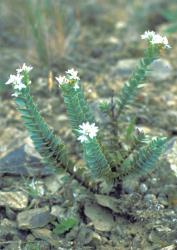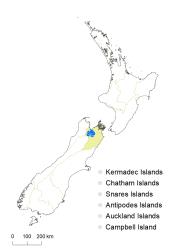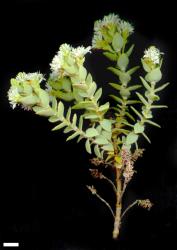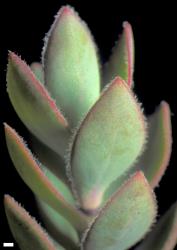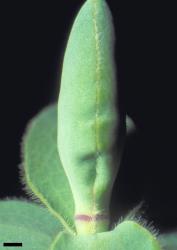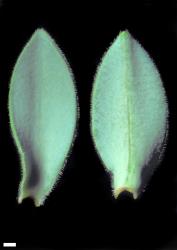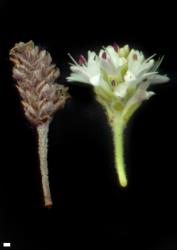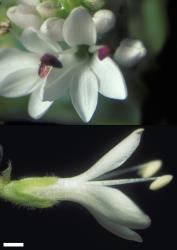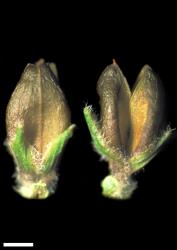- ≡ Hebe gibbsii (Kirk) Cockayne & Allan, Trans. New Zealand Inst. 56: 20 (1926)
Low shrub to 0.35 m tall. Stems decumbent to erect, glabrous or eglandular-pubescent; hairs bifarious. Leaf bud distinct, its leaves appressed at margins until fully grown; sinus absent. Leaves opposite-decussate, erecto-patent to spreading; lamina coriaceous to fleshy, ovate to broadly elliptic, 9–20 mm long, 4–13 mm wide, dull glaucous above and beneath; midrib (at least beneath) and sometimes 2 lateral veins evident; surfaces glabrous; margin ciliate (hairs mostly 0.3–0.8 mm long), entire; apex sub-acute to acute; base cuneate; petiole indistinct, winged, 1–2 mm long. Inflorescence a lateral spike or rarely raceme, 15–35 mm long; flowers crowded, 6–30, all bisexual; bracts opposite below, becoming alternate above, linear to deltoid, ≥ calyx; pedicels absent or rarely erecto-patent, 0–1 mm long, eglandular-hairy all around. Calyx lobes 4, all free or sometimes anterior fused ⅓–⅔ length, acute or sub-acute, 2.0–2.8 mm long, sub-equal, eglandular-ciliate or sometimes the outer face hairy as well. Corolla 5.5–7.0 mm diameter; tube white, 2.5–4.0 mm long, ≥ calyx, glabrous; lobes 4, white, erecto-patent, sub-equal, elliptic or narrowly elliptic, 2.5–3.3 mm long, sub-acute to acute; nectar guides absent. Stamen filaments white, 6.0–6.5 mm long; anthers magenta. Style glabrous or eglandular-hairy, 6.5–9.5 mm long. Capsules latiseptate, acute or sub-acute, glabrous or eglandular-hairy, 2.5–4.0 mm long, 1.6–2.0 mm at widest point. Seeds discoid, ellipsoid, or ovate, flattened, smooth, brown or pale brown, 0.8–1.7 mm long.
The long, fringing hairs on the leaves distinguish V. gibbsii from other hebes with glaucous leaves. The margin of the leaves is bevelled, and the hairs are on the edge of the lamina adjacent to the margin itself, so that they appear as two rows of hairs, at least in dried leaves.
Plants of V. albicans are similar in many respects, but they differ in having glabrous leaf margins, the leaves often broader, especially near the base, and sometimes with eglandular hairs on midribs above, corolla tubes usually hairy, and broader capsules (2.0–3.2 mm wide). Some plants of V. amplexicaulis have hairy leaves, but those are hairy on the surfaces whereas V. gibbsii leaves are hairy on the margins only.
South Island: Sounds Nelson (Ben Nevis, Mt Patriarch, Lake Chalice, Mt Rintoul, Mt Starveall).
Open, rocky sites, mostly above timberline. Recorded elevations range from 854 to 1524 m.
Bayly & Kellow (2006) suggested that one specimen (WELT SP79817, Mt “Z”, Wairau Valley, Martin), which has branched inflorescences and distinctly pedicellate flowers (pedicels to 2 mm long), could be of hybrid origin, perhaps with V. subfulvida (as Hebe divaricata).
Flowers: October–March; fruits: January–May, persisting until November.
2n = 40 (see Bayly & Kellow 2006, as Hebe gibbsii).
Veronica gibbsii is classified in V. subg. Pseudoveronica sect. Hebe and the informal group “Subcarnosae” (Albach & Meudt 2010; Bayly & Kellow 2006). V. gibbsii may be closely related to other glaucous-leaved hebes, such as V. pinguifolia and V. buchananii, which share a number of features. Molecular studies (E.M. Low, unpublished), do not reliably place it, other than within the large hebe clade.
There are a number of additional localities (Dun Mt, Gordon’s Knob, Mt Franklin) not mapped here that are supported by specimens from cultivated, but not wild-collected, plants or for which the locality must be regarded as unproven (Bayly & Kellow 2006).



